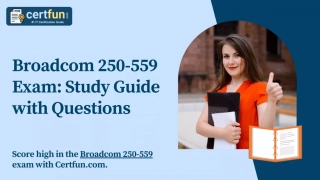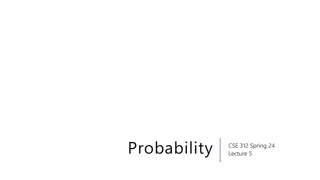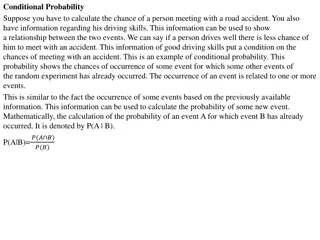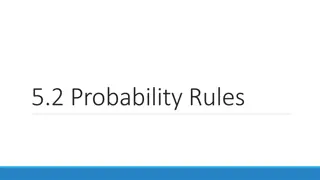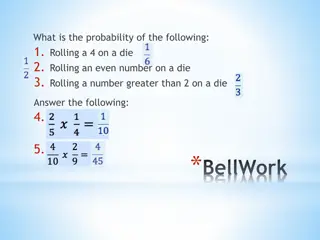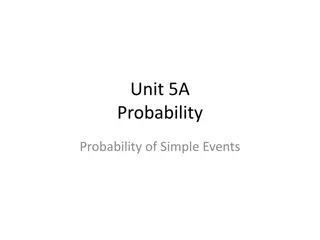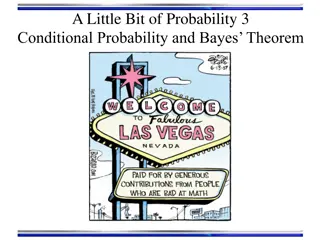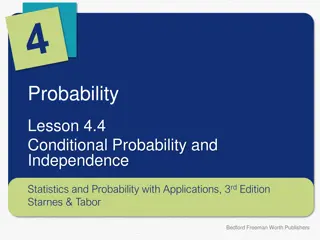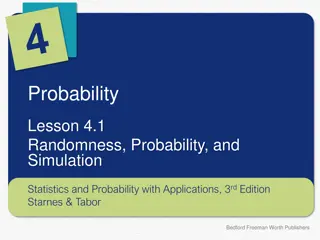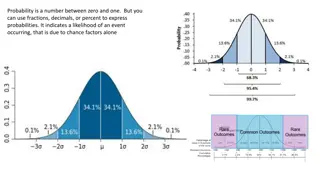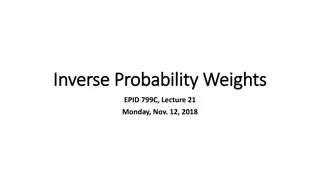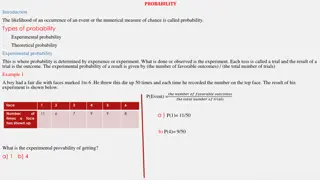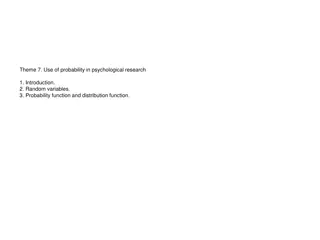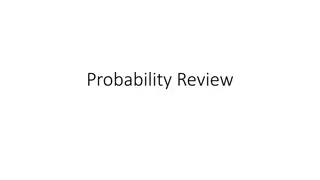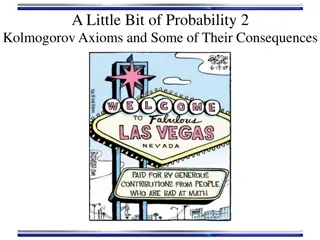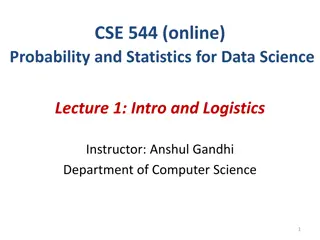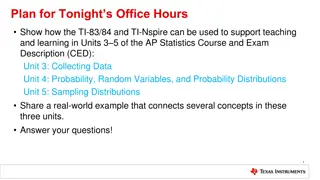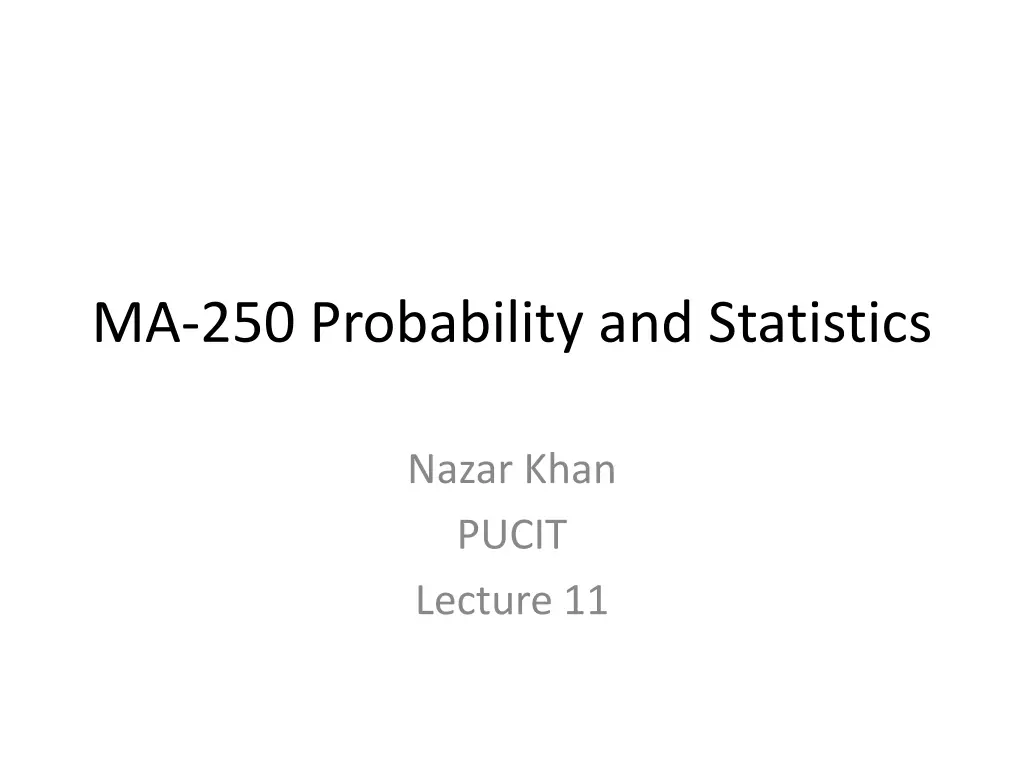
Understanding Probability and Statistics Basics
Dive into the fundamental concepts of probability and statistics, covering random experiments, events, probability functions, axioms of probability, properties of probabilities, and methods for computing probabilities. Explore terminology, sample spaces, and more in this educational lecture series.
Download Presentation

Please find below an Image/Link to download the presentation.
The content on the website is provided AS IS for your information and personal use only. It may not be sold, licensed, or shared on other websites without obtaining consent from the author. If you encounter any issues during the download, it is possible that the publisher has removed the file from their server.
You are allowed to download the files provided on this website for personal or commercial use, subject to the condition that they are used lawfully. All files are the property of their respective owners.
The content on the website is provided AS IS for your information and personal use only. It may not be sold, licensed, or shared on other websites without obtaining consent from the author.
E N D
Presentation Transcript
MA-250 Probability and Statistics Nazar Khan PUCIT Lecture 11
Terminology Random Experiment Anything that produces an uncertain output. Tossing a coin, rolling a die, voting in elections, etc. Outcome What an experiment produces. Coin landing heads, die giving a 6, election resulting in People s Party winning.
Terminology Events The class E of all events that we are interested in is also called a sigma field. It obeys the following axioms 1. S is always considered an event, 2. If A is an event then Acmust also be considered as an event, 3. A countable union of events must also be an event. That is, if A1,A2, are all events then A1 A2 must also be an event.
Terminology When we perform a random experiment. S = sample space E = events in the sample space P = real-valued probability function for events E (P(E) [0,1]) Probability Space: The collection (S,E,P).
Axioms of Probability The probability function P obeys the following axioms: 1. 0 P(A) 1 for any event A, 2. P(S) = 1 and 3. If A1,A2, ... are mutually exclusive events then P(A1 A2 ) = P(A1) + P(A2) +
Properties of P If A,B are events, then 1. P( ) = 0, (impossibility property) 2. P(Ac) = 1 P(A), (complement property) 3. P(Ac B) = P(B) P(A B), (more general complement property) 4. P(A B) = P(A) + P(B) P(A B), (union property) 5. If A B, then P(A) P(B), (monotonicity property)
METHODS FOR COMPUTING PROBABILITIES
Methods for Computing Probabilities 1. By Counting Elements 2. By Measuring Sizes
Probabilities via Counting Elements Simple Sample Space A finite sample space S={ 1, 2, , n} in which every outcome iis equally likely P({ i})=1/n p1+p2+ +pn=1 P(A) = (# elements in A) / (# elements in S) = |A| / |S|
Probabilities via Counting Elements For a simple sample space in which the elements can be counted, probabilities can be computed via counting.
Probabilities via Counting Elements Experiment: Tossing 4 coins S = ? |S|=16 If S is a simple sample space, then every outcome is equally likely: P( i)=1/16 A = getting 3 heads = {HHHT, HHTH, HTHH, THHH} P(HHHT HHTH HTHH THHH) = P(HHHT) + P(HHTH) + P(HTHH) + P(THHH) = 1/16 + 1/16 + 1/16 + 1/16 = 4/16 = |A| / |S|
Probabilities via Counting Elements If S is not a simple sample space, then every outcome is not equally likely P( i) P( j) P(A) |A| / |S|
Experiment: Roll a fair die twice and note the sum of outcomes. Define the sample space? S1={2, 3, 4, 5, 6, 7, 8, 9, 10, 11, 12} Let P1be the probability measure for events in S1. What is P1({3})?
Consider another sample space Entry (i,j) in S2corresponds to the event {i on die 1, j on die 2}.
When will S2be a simple sample space? Assuming fair dice, all combinations {i,j} are equally likely and S2is a simple sample space. So we can compute P1({3}) = P2({1,2}) + P2({2,1}) = 1/36 + 1/36 = 2/36 = 1/18 Probability space (S2,P2) can be used to answer all questions about the experiment. Can we use probability space (S1,P1) to find the probability of the event A={both faces are even}?
Secretarys Matching Problem I want to send letters to N different people. Letters Envelopes N N I randomly put the N letters into the N envelopes. What is the probability of the event A={at least 1 person gets his letter}? For N = 2 letters with 2 envelopes addressed to Kashif and Javed, there are only 2 possibilities, S = {a, b} where a: Kashif gets Javed s letter and Javed gets Kashif s letter, b: Kashif gets Kashif s letter and Javed gets Javed s letter. Because of random placement, outcomes a and b are equally likely. P(A)=P({b})=1/2. Find P(A) when N=4.
Some Crucial Tricks Counting elements can be difficult. So let s consider some tricks for counting elements. The multiplication principle If a task is completed in stages (say 2 stages), so that the first stage can be completed in m ways and the second stage can be completed in n ways then the whole task can be completed in mn ways
A fair die is rolled 3 times. Find the probability that all 3 outcomes will be difficult. S={die1 outcome x die 2 outcome x die 3 outcome} |S|=6*6*6=216 A={all 3 outcomes are different} |A|=6*5*4=120 P(A)=|A|/|S| = 120/216 = 0.5555
There are n people in a room, from which we need to select 3 people, one of which will serve as the president, another as the secretary and the third as the treasurer. How many ways can we make such a selection? President can be chosen from n people. That leaves n-1 people from which the secretary can be chosen. And finally the treasurer can be chosen from the remaining n-2 people. So, total number of ways that the 3 people can be chosen from n people is n*(n-1)*(n-2).
Permutations More generally, k items can be chosen from n items in n*(n-1)*(n-2)* *(n-k-1) ways. n*(n-1)*(n-2)* *(n-k-1) = n!/(n-k)! This is known as the Permutations Formula P(n,k)=n!/(n-k)! It gives the number of ways that k items can be chosen in order from n items.
If 3 people are in a room, what is the probability that no two share the same birthday? Sample space S and its size |S| Event of interest A and its size |A| P(A) = |A| / |S|
Combinations To count the number of ways that k items can be picked at the same time from n items, we use the Combinations Formula C(n,k) = n!/(k!(n-k)!)
A basket contains 8 apples and 9 oranges all mixed up. We reach in, without looking, draw three items all at once. What is the probability that we will get 2 apples and one orange? Describe the sample space S and compute its size |S|. Describe the event of interest A and its size. P(A) = ?
Consider a fully shuffled standard deck of 52 playing cards. Find the probability of receiving 2 pairs while randomly drawing a hand of 5 cards. Sample space S and its size |S| Event of interest A and its size |A| P(A) = |A| / |S| 13 4 4 44 = | | A 2 2 2 1
Probabilities via Measuring Sizes When the sample space can not be counted, but is bounded then probabilities can be computed by measuring sizes. P(A)=length(A) / length(S) P(A)=area(A) / area(S) P(A)=volume(A) / volume(S)
Consider the sample space of points within a circle of radius 3 centered at the origin. S = {(x, y) : x2+ y2 32}. Can you count the number of points in S? No Let the event A={x coordinate is >= 0}. A is represented by the blue area. S is the whole area of the circle. P(A) = area(A) / area(S) = 1/2
We randomly chose a point between [0,5]. What is the probability that it lies between 2 and 3.5?
Find the probability that a point chosen at random from within the circle of radius r lies in the blue square with side lengths 2. S={all points in circle of radius r} A={all points in the blue 2x2 square} P(A)=?
A dart is randomly thrown at the region S={(x,y): y x2, 0 < x < 4} and the x-coordinate of landed spot is noted. What is the chance that the x-coordinate will lie in the interval [3,4]?
Problem of Galileo: Italian gamblers were puzzled as to why a sum of 10 on three rolls of a fair die seemed to occur more often than a sum of 9. Galileo wrote down the sample space and took away the mystery. Explain the mystery.




